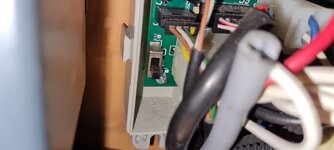Hi All,
The electrical system in my van is very confusing. I have 3 x 100AH Gel House batteries. For some reason it appears that the 12v side of the van is draining the starter battery. Under the drivers seat there are 2 batteries and from what I can trace, the starter battery gives a supply to charge the auxiliary battery, when the relay allows it. But, it appears that the cables from the solar controller and the cbe ds300 go to the auxiliary battery, not to the house battery bank. As I type this, I have my generator running and my Victron Blue Smart 12v 30A charger, connected to the cables that went from the cbe ds300 to the charge controller. I started with the charger connected to the house batteries and they were full but I was still seeing 11.5v on a USB socket, powered by the cbe ds300. You can see the difference in the screenshots attached. The time difference between these screenshots is 7 minutes, while I changed the charger connections.
I am getting everything ready to convert the system to 600AH Lifepo4 / Victron solar system. My question is, as other wiring is a mess I will be renewing everything, with the correct cable and fuses etc. Obviously I will be removing the original CBE charger and any other unnecessary parts. I want to end up with 1 x 50A 12v supply, from the new house batteries, to the cbe ds300 and allow that to run the original house 12v system.
Is this possible? If yes, which cables need to be removed or added to the cbe ds300? If not, what can be done, to discard as many cables as possible.
I feel that the entire system has been played with by multiple installers and additions to the system.
Any advice / suggestions welcome.
The electrical system in my van is very confusing. I have 3 x 100AH Gel House batteries. For some reason it appears that the 12v side of the van is draining the starter battery. Under the drivers seat there are 2 batteries and from what I can trace, the starter battery gives a supply to charge the auxiliary battery, when the relay allows it. But, it appears that the cables from the solar controller and the cbe ds300 go to the auxiliary battery, not to the house battery bank. As I type this, I have my generator running and my Victron Blue Smart 12v 30A charger, connected to the cables that went from the cbe ds300 to the charge controller. I started with the charger connected to the house batteries and they were full but I was still seeing 11.5v on a USB socket, powered by the cbe ds300. You can see the difference in the screenshots attached. The time difference between these screenshots is 7 minutes, while I changed the charger connections.
I am getting everything ready to convert the system to 600AH Lifepo4 / Victron solar system. My question is, as other wiring is a mess I will be renewing everything, with the correct cable and fuses etc. Obviously I will be removing the original CBE charger and any other unnecessary parts. I want to end up with 1 x 50A 12v supply, from the new house batteries, to the cbe ds300 and allow that to run the original house 12v system.
Is this possible? If yes, which cables need to be removed or added to the cbe ds300? If not, what can be done, to discard as many cables as possible.
I feel that the entire system has been played with by multiple installers and additions to the system.
Any advice / suggestions welcome.




















